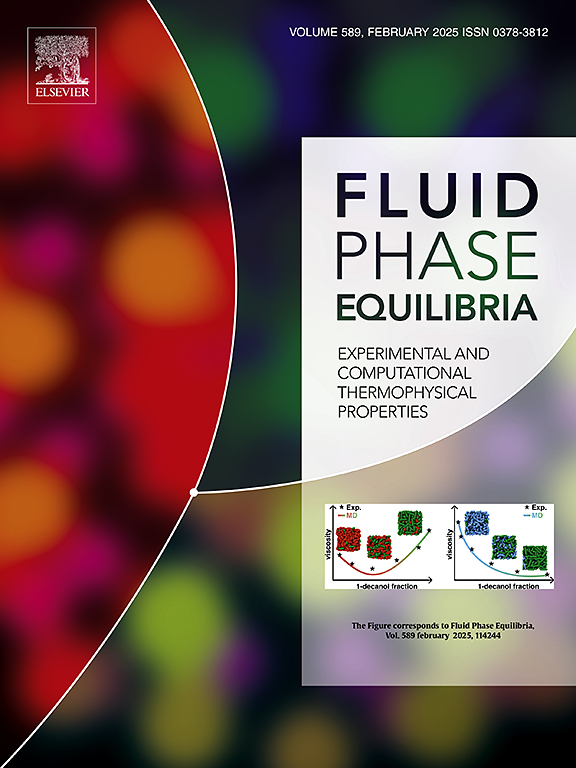评价非极性化合物衍生物性质预测的热力学模型
IF 2.8
3区 工程技术
Q3 CHEMISTRY, PHYSICAL
引用次数: 0
摘要
热力学模型已经发展了几十年,但在确定特定系统的最有效模型方面仍然存在一个持续的挑战。在本研究中,我们分析了包括SRK、PR、CPA、CK-SAFT、PC-SAFT、SAFT- vr Mie、SAFT-γ Mie和GERG-2008在内的多种热力学模型,以评估它们在预测烷烃、N₂和CO₂等化合物的一阶和二阶导数性质方面的性能。性质,如饱和压力,液体密度,等压和等时热容,包括他们的残余项,声速,焦耳-汤姆逊系数已被检查。虽然GERG-2008作为一个多参数状态方程,在大多数性质上始终优于其他模型,但在一般热力学模型中,SAFT- vr Mie和SAFT-γ Mie表现出优于传统立方模型的性能,特别是在预测二阶导数性质方面,PC-SAFT在等压热容量和焦耳-汤姆逊系数方面表现出优异的结果。为了更深入地了解结果,进一步检查了模型在预测选定二阶导数属性(dP/dT, dP/dV,(∂2Ares/∂V2)T,n,(∂2Ares/∂T∂V)n和(∂2Ares/∂T2)V,n)方面的性能。此外,还分析了硬球项、链项和色散项对亥姆霍兹能量二阶导数的贡献,强调了这些项对体积和温度导数的重要影响。本文还讨论了这些模型的预测能力可能面临的挑战和潜在的改进。本文章由计算机程序翻译,如有差异,请以英文原文为准。
Evaluation of thermodynamic models for the prediction of derivative properties for non-polar compounds
Thermodynamic models have been developed for many decades, while a persistent challenge remains in identifying the most effective model for specific systems. In this study, a wide range of thermodynamic models, including SRK, PR, CPA, CK-SAFT, PC-SAFT, SAFT-VR Mie, SAFT-γ Mie, and GERG-2008, have been analyzed to evaluate their performance in predicting the first- and second-order derivative properties of compounds such as alkanes, N₂, and CO₂. Properties such as saturation pressure, liquid density, isobaric and isochoric heat capacities including their residual terms, speed of sound, and Joule-Thomson coefficient have been examined. While GERG-2008, as a multiparameter equation of state consistently outperforms other models across most properties, among general thermodynamic models, SAFT-VR Mie and SAFT-γ Mie have demonstrated superior performance over conventional cubic models, particularly in predicting second-order derivative properties, and PC-SAFT has shown superior results for isobaric heat capacity and Joule-Thomson coefficient. To gain deeper insights into the results, further examination of the model's performance in predicting selected second-order derivative properties (dP/dT, dP/dV, , , and ) has been conducted. Additionally, the contributions of hard-sphere, chain, and dispersion terms to the second-order derivatives of Helmholtz energy have been analyzed, highlighting the significant impact of these terms on volume and temperature derivatives. This manuscript also discusses possible challenges and potential improvements in these models' predictive capabilities.
求助全文
通过发布文献求助,成功后即可免费获取论文全文。
去求助
来源期刊

Fluid Phase Equilibria
工程技术-工程:化工
CiteScore
5.30
自引率
15.40%
发文量
223
审稿时长
53 days
期刊介绍:
Fluid Phase Equilibria publishes high-quality papers dealing with experimental, theoretical, and applied research related to equilibrium and transport properties of fluids, solids, and interfaces. Subjects of interest include physical/phase and chemical equilibria; equilibrium and nonequilibrium thermophysical properties; fundamental thermodynamic relations; and stability. The systems central to the journal include pure substances and mixtures of organic and inorganic materials, including polymers, biochemicals, and surfactants with sufficient characterization of composition and purity for the results to be reproduced. Alloys are of interest only when thermodynamic studies are included, purely material studies will not be considered. In all cases, authors are expected to provide physical or chemical interpretations of the results.
Experimental research can include measurements under all conditions of temperature, pressure, and composition, including critical and supercritical. Measurements are to be associated with systems and conditions of fundamental or applied interest, and may not be only a collection of routine data, such as physical property or solubility measurements at limited pressures and temperatures close to ambient, or surfactant studies focussed strictly on micellisation or micelle structure. Papers reporting common data must be accompanied by new physical insights and/or contemporary or new theory or techniques.
 求助内容:
求助内容: 应助结果提醒方式:
应助结果提醒方式:


